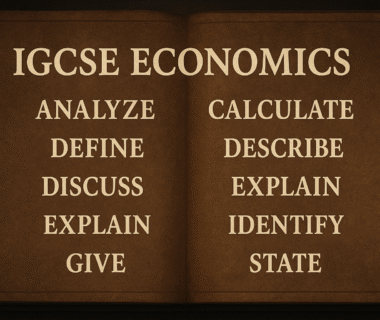Today’s blog post is about what we call command words in the IGCSE.
Command words are extremely important because these are the words that you’re going to see in every IGCSE question.
Each one has a specific meaning as identified by Cambridge, and it is crucial to understand all of them in order to understand how you should respond.
…How wonderful that your beloved sepupu has compiled not only a list of your command words but also will be demonstrating how to make use of them!
Without further ado, here are your command words as taken from the IGCSE Cambridge Economics syllabus – these were the same across the 2023 -2025, 2026, and 2027-2029 syllabi – behold!

Now that you know what the command words are, let’s look at some tangible examples of situations where they would be used and how they would be used.
Ready?
Let’s go!
1. Analyse
“Examine in detail to show meaning, identify elements and the relationship between them.”
Example Question:
Analyse how an increase in interest rates might affect consumer spending and borrowing.
What to Do:
- Identify the elements: interest rates, consumer spending, borrowing.
- Show the relationships: Higher interest → costlier loans → less borrowing → lower spending.
- Include linking phrases like: “This leads to…”, “As a result…”, “Consequently…”.
✅ Use:
“As interest rates increase, the cost of borrowing rises. This discourages consumers from taking loans for major purchases such as cars and homes. At the same time, saving becomes more attractive, reducing overall consumer expenditure.”
2. Calculate
“Work out from given facts, figures or information.”
Example Question:
Calculate the price elasticity of demand using the following data: Price rises from $10 to $12, quantity demanded falls from 100 to 80.

3. Define
“Give precise meaning.”
Example Question:
Define opportunity cost.
✅ Answer:
“Opportunity cost is the next best alternative foregone when a decision is made to use scarce resources for one purpose over another.”
✳️ No examples needed unless asked for.
4. Describe
“State the points of a topic / give characteristics and main features.”
Example Question:
Describe the characteristics of a mixed economy.
✅ Answer:
“A mixed economy is one where both the private sector and the government are involved in resource allocation. It combines features of a market economy, such as private ownership and profit motive, with government intervention in areas like education and healthcare.”
🔹 This is factual, descriptive — not evaluative. You are not expected to talk about whether a mixed economy is good or bad. You are only meant to retrieve your understanding and memory of what you are being asked about.
5. Discuss
“Write about issue(s) or topic(s) in depth in a structured way.”
Example Question:
Discuss whether a government should subsidise the production of electric vehicles.
✅ Answer Structure:
- Introduction of the issue
- Arguments for subsidies: reduce pollution, encourage innovation
- Arguments against: opportunity cost, risk of inefficiency
- Conclusion: balanced, thoughtful judgment
✅ Answer Snippet:
“Subsidising electric vehicle production can encourage environmentally friendly transport and reduce emissions. However, it may be costly for governments and could distort the market. Whether it is justified depends on the long-term environmental and economic benefits.”
6. Explain
“Set out purposes or reasons / make the relationships between things clear.”
Example Question:
Explain why inflation can hurt savers.
✅ Answer:
“Inflation reduces the purchasing power of money. If savers keep their money in accounts with low interest rates, the real value of their savings falls, meaning they can buy less with the same amount of money over time.”
✳️ Look for cause-effect chains. To get good at this, start thinking about how everything you are learning relates together and ask yourself how different factors can affect one another. Don’t just commit things to memory but actually think about the common sense implications of how certain factors can cause other things to happen. Get used to doing that repeatedly.
7. Give
“Produce an answer from a given source or recall/memory.”
Example Question:
Give one example of a merit good.
✅ Answer:
“Education.”
✳️ Usually just a one-word or short-phrase recall question.
8. Identify
“Name/select/recognise.”
Example Question:
Identify two causes of unemployment.
✅ Answer:
“Cyclical unemployment, structural unemployment.”
✳️ Similar to “Give”, but may come with options or lists.
9. State
“Express in clear terms.”
Example Question:
State one function of a central bank.
✅ Answer:
“To control the money supply.”
✳️ Be concise, clear, and exact.
Hope this was helpful to you. Thank you for reading, and look forward to seeing you in the next ones!
V.
